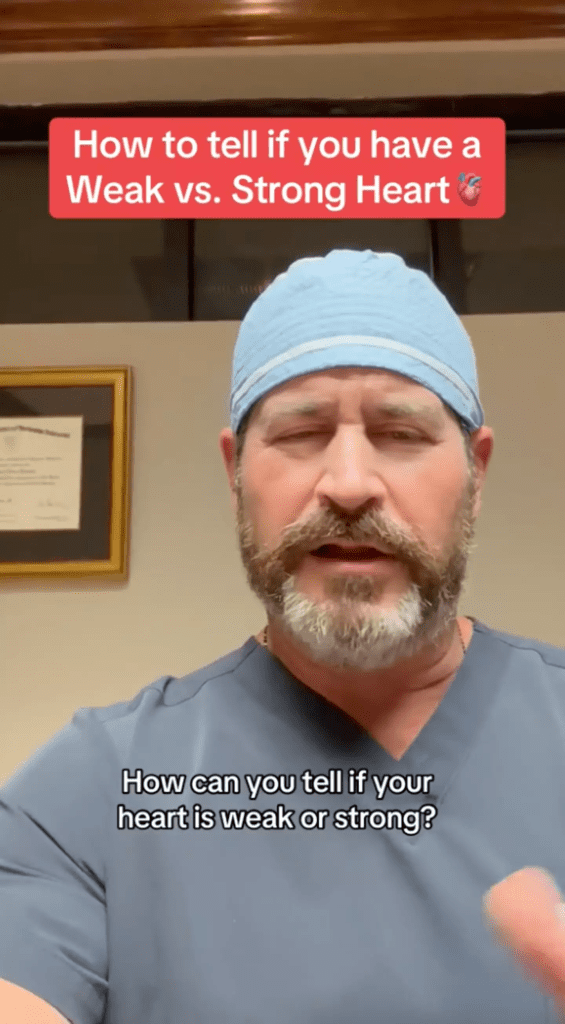Your heart is at the center of your health, silently working hard to keep you moving. But how can you tell if it’s functioning optimally or showing signs of weakness? Cardiovascular surgeon Dr. Jeremy London has shared some essential “red flags” to help you assess whether your heart might need attention. From shortness of breath to swollen legs, these signs can indicate if your ticker is in great shape—or if it’s time to seek medical advice. Here’s how you can take a closer look at your heart’s health.
Shortness of Breath: A Common Warning Sign

One of the earliest and most common indicators of a weak heart is shortness of breath. If you find yourself struggling to catch your breath during simple activities like walking or climbing stairs, it could be more than just being out of shape. According to Dr. London, difficulty breathing while performing light activities may signal that your heart isn’t pumping blood efficiently, which can be a sign of heart failure or other cardiovascular conditions.
The British Heart Foundation emphasizes the importance of taking breathlessness seriously, as it can result from treatable heart conditions, such as coronary heart disease, heart failure, or arrhythmias like atrial fibrillation. If you notice this symptom, don’t ignore it; schedule a check-up with your doctor.
Difficulty Lying Flat: A Sign of Orthopnea
Another indicator of a weak heart is experiencing shortness of breath when lying down, a condition known as orthopnea. If you find it difficult to breathe comfortably while lying flat and feel relief only when sitting or standing up, this could be a sign of fluid buildup in your lungs. Orthopnea is often associated with heart failure, as a weakened heart struggles to pump blood effectively, causing fluid retention in the lungs.
This symptom might go unnoticed until you lie down, making it easy to dismiss as a minor discomfort. However, if you need extra pillows or feel uncomfortable lying flat, consider this a red flag and speak to a healthcare professional.
Swollen Legs and Ankles: A Symptom of Fluid Retention
@drjeremylondon Weak vs. Strong Heart #doctor #surgeon #hearthealth #heartsurgery #fypシ ♬ original sound – Dr. Jeremy London, MD
Swollen legs and ankles are often overlooked, but they can be a clear indication of heart weakness. When your heart isn’t functioning well, blood flow slows, causing fluid to build up in your legs, ankles, and sometimes even your abdomen. This condition, known as edema, occurs because a weak heart struggles to pump blood back up from the legs, leading to fluid pooling in the lower body.
The NHS confirms that swelling in the lower body is a common symptom of heart failure. If you notice consistent swelling, especially by the end of the day, it’s wise to consult a doctor to determine the underlying cause.
Fatigue and Weakness: When Everyday Activities Feel Exhausting
A weak heart often leads to fatigue and general weakness. If tasks that once felt effortless, like climbing stairs or carrying groceries, leave you drained, it could be due to poor blood circulation. When the heart is too weak to pump blood effectively, your body struggles to deliver oxygen to the muscles, causing early exhaustion.
While occasional tiredness is normal, persistent fatigue—especially when accompanied by other symptoms like shortness of breath or swelling—can be a serious sign that your heart isn’t in peak condition. Prioritize a visit to your doctor if you’re consistently feeling unusually tired.
Rapid or Irregular Heartbeat: A Potential Sign of Arrhythmia

While a racing heart after exercise is normal, experiencing a rapid or irregular heartbeat during rest could indicate an arrhythmia. Arrhythmias occur when the heart’s electrical signals are disrupted, causing the heart to beat irregularly or too quickly. Conditions such as atrial fibrillation, a common type of arrhythmia, can increase the risk of heart failure and stroke.
Dr. London advises that while an irregular heartbeat doesn’t always signal a weak heart, it is essential to get it checked out, especially if it’s accompanied by other symptoms. An echocardiogram or EKG can determine if there’s an underlying issue.
Chest Discomfort: When to Take It Seriously
Chest discomfort, tightness, or pressure is one of the most recognizable red flags for heart problems. However, not all chest pain is intense or dramatic. For some, it may feel like mild pressure or discomfort that comes and goes. If you notice this sensation, especially during physical activities or periods of stress, it could be an early warning sign of coronary artery disease or even a weak heart.
Chest pain should never be ignored, as it can be the first sign of an impending heart attack or other serious condition. If you experience chest discomfort, reach out to a healthcare provider as soon as possible for a proper evaluation.
How Doctors Assess Heart Strength
Dr. London explains that assessing heart strength is crucial for understanding overall cardiovascular health. One of the most effective ways to measure heart function is through an echocardiogram, which can determine the heart’s ejection fraction (EF). Ejection fraction measures the percentage of blood the heart pumps out with each beat. A healthy EF is between 65% and 70%, while a significantly lower percentage can indicate heart failure or other weaknesses.

An echocardiogram provides a clear image of the heart’s structure and functioning, allowing doctors to diagnose problems that might not be apparent through symptoms alone. Dr. London highlights that patients with strong hearts often fare better with surgeries and recover more quickly than those with weakened hearts, making this assessment a critical step in managing heart health.
Tips for Strengthening Your Heart Naturally
While regular check-ups are essential, there are steps you can take to maintain a strong and healthy heart:
- Exercise Regularly: Cardiovascular exercises like walking, swimming, and cycling can improve heart strength. Aim for 150 minutes of moderate activity each week to boost circulation and endurance.
- Eat Heart-Healthy Foods: Incorporate foods rich in fiber, antioxidants, and healthy fats. Fresh fruits, vegetables, whole grains, and nuts support heart health, while limiting processed foods, sugars, and saturated fats is beneficial.
- Manage Stress: Chronic stress takes a toll on your heart, so prioritize relaxation and self-care practices like meditation or deep breathing exercises.
- Avoid Smoking and Limit Alcohol: Smoking and excessive alcohol intake can weaken your heart. Quitting smoking and limiting alcohol are key steps in protecting your cardiovascular health.
- Regular Check-Ups: Routine heart screenings, especially if you’re at risk for heart disease, can help catch any issues early, allowing for preventive care.
Conclusion
Being attentive to your body’s signals can make all the difference in detecting heart problems early. From shortness of breath and swollen legs to difficulty lying flat, these red flags should never be ignored. Dr. London’s insights remind us that a proactive approach, regular check-ups, and lifestyle changes are vital for a healthy heart. So, keep an eye on these signs, take them seriously, and make heart health a top priority.


